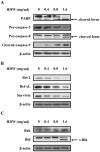Synergistic inhibition of leukemia WEHI-3 cell growth by arsenic trioxide and Hedyotis diffusa Willd extract in vitro and in vivo
- PMID: 28587418
- PMCID: PMC5450767
- DOI: 10.3892/etm.2017.4392
Synergistic inhibition of leukemia WEHI-3 cell growth by arsenic trioxide and Hedyotis diffusa Willd extract in vitro and in vivo
Abstract
Arsenic trioxide (ATO) is clinically used to treat acute promyelocytic leukemia (APL); however, the therapeutic dose of ATO may prompt critical cardiac side effects. Combination therapy may be used to improve the therapeutic efficiency. To evaluate this possibility, the present study determined the combined effects of Hedyotis diffusa Willd (HDW) extract and ATO in leukemic WEHI-3 cells. The results demonstrated that co-treatment of HDW with ATO resulted in a synergistic augmentation of cytotoxicity in cells at the concentration tested. In order to investigate the potential therapeutic application for leukemia, the combined effects of HDW and ATO were analyzed on the WEHI-3 cell-induced orthotopic leukemia animal model in vivo. The WEHI-3 cells in mice with leukemia were established by injecting murine WEHI-3 cells into BALB/c mice, and treating them with HDW and/or combined with ATO. The results indicated that HDW alone or HDW combined with ATO promoted the total survival rate of mice with leukemia, and these effects are dose-dependent. HDW alone or HDW combined with ATO did not affect the body weight, decreased the spleen weight and did not affect the liver weight. Furthermore, the results demonstrated that HDW alone or HDW combined with ATO resulted in a synergistic augmentation of apoptosis in WEHI-3 cells at the concentration tested. In order to further reveal the detailed mechanism of this synergistic effect on apoptosis, apoptosis-related proteins were also evaluated. The data revealed that HDW alone or HDW combined with ATO induced the expression of death receptor 4 (DR4) and DR5 and the activation of poly adenosine diphosphate ribose polymerase, caspase-3, -8 and -9. Furthermore, HDW alone or HDW combined with ATO decreased the expression levels of B-cell lymphoma 2, B-cell lymphoma-extra large and survivin, and increased the expression levels of Bak and t-Bid. Altogether, the results indicate that the combination of HDW with ATO may be a promising strategy used to increase the clinical efficacy of ATO in the treatment of APL.
Keywords: Hedyotis diffusa Willd; acute promyelocytic leukemia; apoptosis; arsenic trioxide; death receptor.
Figures






Similar articles
-
Extract of Hedyotis diffusa Willd influences murine leukemia WEHI-3 cells in vivo as well as promoting T- and B-cell proliferation in leukemic mice.In Vivo. 2011 Jul-Aug;25(4):633-40. In Vivo. 2011. PMID: 21709007
-
Ethanol extract of Hedyotis diffusa willd upregulates G0/G1 phase arrest and induces apoptosis in human leukemia cells by modulating caspase cascade signaling and altering associated genes expression was assayed by cDNA microarray.Environ Toxicol. 2015 Sep;30(10):1162-77. doi: 10.1002/tox.21989. Epub 2014 Mar 28. Environ Toxicol. 2015. PMID: 24677778
-
Arsenic trioxide (As₂O₃) inhibits murine WEHI-3 leukemia in BALB/c mice in vivo.Environ Toxicol. 2012 May;27(6):364-71. doi: 10.1002/tox.20650. Epub 2010 Sep 30. Environ Toxicol. 2012. PMID: 20886602
-
Treatment of acute promyelocytic leukaemia with all-trans retinoic acid and arsenic trioxide: a paradigm of synergistic molecular targeting therapy.Philos Trans R Soc Lond B Biol Sci. 2007 Jun 29;362(1482):959-71. doi: 10.1098/rstb.2007.2026. Philos Trans R Soc Lond B Biol Sci. 2007. PMID: 17317642 Free PMC article. Review.
-
An efficient therapeutic approach to patients with acute promyelocytic leukemia using a combination of arsenic trioxide with low-dose all-trans retinoic acid.Hematol Oncol. 2004 Jun;22(2):63-71. doi: 10.1002/hon.728. Hematol Oncol. 2004. PMID: 15468344 Review.
Cited by
-
The Antitumor Constituents from Hedyotis Diffusa Willd.Molecules. 2017 Nov 30;22(12):2101. doi: 10.3390/molecules22122101. Molecules. 2017. PMID: 29189741 Free PMC article.
-
Clinical Indicators of Hepatotoxicity in Newly Diagnosed Acute Promyelocytic Leukemia Patients Undergoing Arsenic Trioxide Treatment.Biol Trace Elem Res. 2024 Jan;202(1):122-132. doi: 10.1007/s12011-023-03676-2. Epub 2023 Apr 25. Biol Trace Elem Res. 2024. PMID: 37097388 Free PMC article.
-
Bufalin Enhances Immune Responses in Leukemic Mice Through Enhancing Phagocytosis of Macrophage In Vivo.In Vivo. 2018 Sep-Oct;32(5):1129-1136. doi: 10.21873/invivo.11355. In Vivo. 2018. PMID: 30150435 Free PMC article.
-
Effect of arsenic trioxide on cervical cancer and its mechanisms.Exp Ther Med. 2020 Dec;20(6):169. doi: 10.3892/etm.2020.9299. Epub 2020 Oct 9. Exp Ther Med. 2020. PMID: 33101463 Free PMC article.
-
An overview of arsenic trioxide-involved combined treatment algorithms for leukemia: basic concepts and clinical implications.Cell Death Discov. 2023 Jul 27;9(1):266. doi: 10.1038/s41420-023-01558-z. Cell Death Discov. 2023. PMID: 37500645 Free PMC article. Review.
References
-
- Maeda H, Hori S, Nishitoh H, Ichijo H, Ogawa O, Kakehi Y, Kakizuka A. Tumor growth inhibition by arsenic trioxide (As2O3) in the orthotopic metastasis model of androgen-independent prostate cancer. Cancer Res. 2001;61:5432–5440. - PubMed
-
- Shen ZY, Shen J, Cai WJ, Hong C, Zheng MH. The alteration of mitochondria is an early event of arsenic trioxide induced apoptosis in esophageal carcinoma cells. Int J Mol Med. 2000;5:155–158. - PubMed
-
- Uslu R, Sanli UA, Sezgin C, Karabulut B, Terzioglu E, Omay SB, Goker E. Arsenic trioxide-mediated cytotoxicity and apoptosis in prostate and ovarian carcinoma cell lines. Clin Cancer Res. 2000;6:4957–4964. - PubMed
LinkOut - more resources
Full Text Sources
Other Literature Sources
Research Materials
